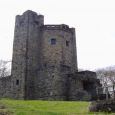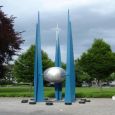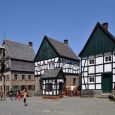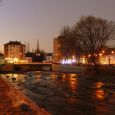Hagen
Advertisement
By Air
Hagen airport ( special landing strip ) with the ICAO ED6015 and at court choice (consisting of a green lawn) about 1.5 kilometers northeast of Hasper Dam, nestled in an idyllic woodland. Landing permission for non-club members are not given there.Plans for a commercial airport in Hagen-Emst were abandoned by the city council as early as the 1930s.
By Train
Hagen has been an important rail junction for the southeastern Ruhr valley since the first rail line opened in 1848.The shunting yard of Hagen-Vorhalle is among Germany's largest, and the central station offers connections to the ICE network of Deutsche Bahn as well as to local and S-Bahn services.Since December 2005, Hagen has also been the starting point for a new service into Essen, operated by Abellio Rail.Local traffic is handled by Hagener Strabenbahn (Hagen Tramways), which, despite its name, offers only bus services, as the last tramway in Hagen went out of service in the 1970s.All local rail and bus services operate under the transport association VRR.The rail network is in Hagen on the ICE network connected - from the Hagen Central Station depart regularly-distance trains, both nationally and internationally.Hagen is also important interface motorway links north-south and east-west direction.
By Road
On the run Hagen city highways with a total length of 32.7 km. A 1 / E 37 (Hansa Line), 10.7 km, A 45 / E 41 (Sauerlandlinie) 14.8 km, A 46 7.2 km. Hagen has the following motorway access points: North-Hagen, Hagen-West (A1), Hagen-Süd (A45); Hohenlimburg Hagen, Hagen-Elsey (A46).By the Hagen city roads lead B7 , B54 and B226 with a total distance of 41.0 km.
Castle Werdringen
is a water castle in Hagen-porch near the clock on Harkortsee below the Kaisbergs.It houses a pan-regional museum of prehistory and early history.Originally built as a moated castle lies in a nature and landscape conservation area surrounded by mature trees.In the moats and ditches of the castle rare animal and plant species are found.The landscape around the Water Palace is known for a diverse amphibian fauna and many protected dragonfly species, including the largest occurring in Central Europe dragonflies. It is attractive, the fossils of the ancestors of amphibians and dragonflies at the Museum of Prehistory and Early History, located in the former castle to watch.The immediate surroundings of the castle is a historic landscape and counts for over 200 years of the most important discoveries of fossils and archaeological finds areas. Not far from the castle is the former quarry Hagen porch.There, the world's oldest known flying insects of the earth were discovered.They lived some 316 million years of carbon.
LWL Open-Air Museum Hagen
is an open-air museum in Hagen district SELBECK Mackingerbachtal in the southeastern Ruhr . The carrier's Regional Association of Westphalia-Lippe (LWL).Unlike most European open air museums dedicated to the WFH is not the representation of the peasant and rural life, but the history of craft and technique.Since the 1920s there were efforts of a group of engineers and home guards, technical monuments to preserve it for posterity. The initiator Wilhelm Claas suggested already by 1930 the Mäckingerbachtal ago as a site for an appropriate museum. The narrow valley in the foothills of the Sauerland region offers, for the trade in 18th and 19 Century most important natural site factors of wind, water and forest.The museum is open seasonally from 1 April 31 October. On the first weekend of Advent in the museum for three days a Christmas market place. In the higher part of the museum with a village clustered houses and in the printing and paper, the houses are on these days with garlands adorned. In the homes of stalls and goods are mainly from the fields of arts and crafts and food sold.
Osthaus Museum Hagen
is one for the art patron Karl Ernst Osthaus named municipal art museum of modern art in Hagen.A new art museum, the city's " Christian-Rohlfs-museum "was opened in 1930 in the Villa post. It was in the era of National Socialism brought into line in 1934 and Municipal Museum - Museum of Fine Arts renamed. Due to the exhibition of Degenerate Art , it lost much of its holdings, including about 400 works by Christian Rohlfs . Other stocks were in the Second World War is lost.The reopening of the museum under the name of Karl-Ernst-Museum Osthaus end of 1945 the collection had to be rebuilt. In 1955, the Folkwang-old building on the high street are again occupied, which was later converted strong. A restoration and partial reconstruction of the Art Nouveau interiors by Henry van de Velde was funded by donations and by the opening of the great Henry van de Velde Exhibition in 1991, completed. At the same time was also a reorientation of the museum.The Karl-Ernst-Osthaus museum was closed from 2006 until late August 2009. The reopening under the name Osthaus Museum Hagen made jointly with the opening of Emil Schumacher Museum.Both museums now form the Kunstquartier Hagen.
Theater Hagen
as a fifth Inaugurated in October 1911 and is located in historic buildings in Hagen city. About 162,000 visitors annually with its focus on music and the theater is the theater one of the city to famous landmarks and cultural attractions.The foundation went back to an initiative of the Association and the Theater Hagen Hagen Concert Society in 1901. Eight years later, was then launched with the help of many donations from the citizens of the Theatre Company into being. Since then, understands the theater to this day as "bourgeois theater."The Hagen theater is largely determined by tax money paid by the city of Hagen funded, project-oriented theater also receives state funds.Towards the end of the Second World War on 15 March 1945 by a major American attack bombers, the theater building was largely destroyed, but rebuilt after the war. On 6 September 1949, reopened it.
Eugen Richter Turm
is a twin-towered complex of quarry stone, above the rectangular base level, the tower stands as the octagonal tower.In the Hall of Honour in the basement were originally busts of Freiherr vom Stein, Diesterweg, Natorp and Harkort.The tower was built in 1911, lies at an altitude of 285 m and has a total height of 23 meters.He is part of the Hagen 6 km long "three-way towers" from Eugen-Richter-Turm, Bismarck Tower and Kaiser-Friedrich-Turm.Close proximity to Eugen-Richter-tower there is also the Public Observatory Hagen.
May - August
January - March






